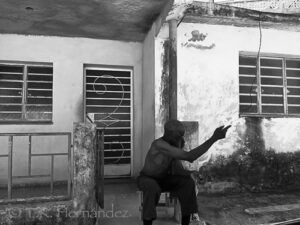Notes: The following is an excerpt of an interview with Aaron Kelly of the Defence of Humanity, Irish Chapter, a website for artists, intellectuals and social movements that defend humanity.

To celebrate the publication of her stunning collection of photographs of Havana, T.K. Hernández is interviewed by Aaron Kelly, Coordinator of the Irish Chapter of the Network in Defence of Humanity.
Aaron Kelly: Thank you so much for agreeing to be interviewed about your brilliant collection of evocative photographs, Chance and Desire: Havana in Black & White (2020). It’s a real honour to be able to talk with you about your work. One of the many remarkable things about the collection is that you took the photographs across quite a long period of time (2002-2019), and yet you retain a really lucid and striking stylistic and compositional consistency. Could you tell us a bit about your own, quite distinctive, and alluring aesthetic of street documentation, your decision to work in black and white, and what factors drew you to your fine photographic vocation in the first place?
TKH: I think the consistency in style may have to do with my way of seeing things. My perspective. My vision. That may be a difficult thing to change in an individual. Cities excite me, I am concerned with truth. I also work in colour but for this book I wanted black and white. I wanted it to be hardcore truth and have the impact and “grittiness” typically found in street or war photography.
Although the latest trend in street photography has been to use colour, I have been heavily influenced in my life by the work of Diane Arbus and Henri Cartier-Bresson. My photos in this book are also a kind of reaction against the sudden proliferation of HDR resolution images of Havana that emerged in the Obama years. They give a kind of “Disneyland” perspective, to me, anyways. Yes, they are nice, but Havana doesn’t look like that.
What drew me to photography? I’m not sure exactly. Photography is in my family. And I have an “eye.” I realized this early on in my work. I become breathless when I am in a foreign place/city and have a camera in hand. I want to capture the memory because I may never return again. I need this kind of permanence in a transcendent world. Photography is a way of immortalizing memory. I am extremely interested in people and, although this book is not in colour, colour excites me immensely. I am currently working on two books, one has nothing to do with photography and the other is my photography and it’s in brilliant colour.
AK: At some level, the collection is a personal hymn to the wonderful city of Havana. You mention in your introduction to the book that the words, ‘I’m in Havana and I’ve never felt more alive. I feel like I can breathe’, scribbled on a wall at the Anacaona Restaurant of the Hotel Saratoga, left a lasting impression on you. The interplay between that evocative, lasting impression and the idea of transience – the anonymity of the lost author of those words, your chance encounter with those words, the fact that those words themselves will be rewritten, or erased, or painted over – is very apt for your work itself. Your photographs memorialise moments, they exquisitely transmute transience into lasting stills: is this something you feel photography is particularly well suited to achieving? And do you feel Havana as a place is itself particularly given to this kind of celebration of life and its vicissitudes?
Read the rest of the interview on Ireland in Defence of Humanity.